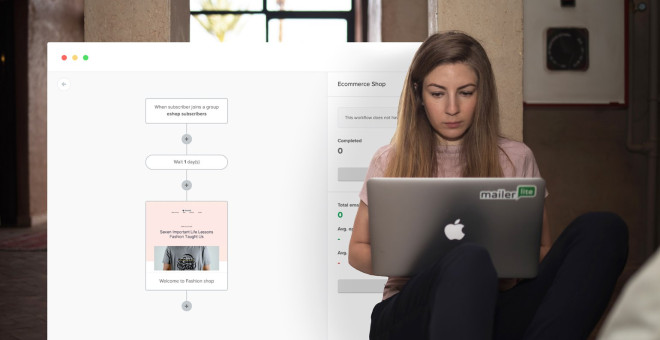The complete guide to nurture email campaigns that turn leads into sales
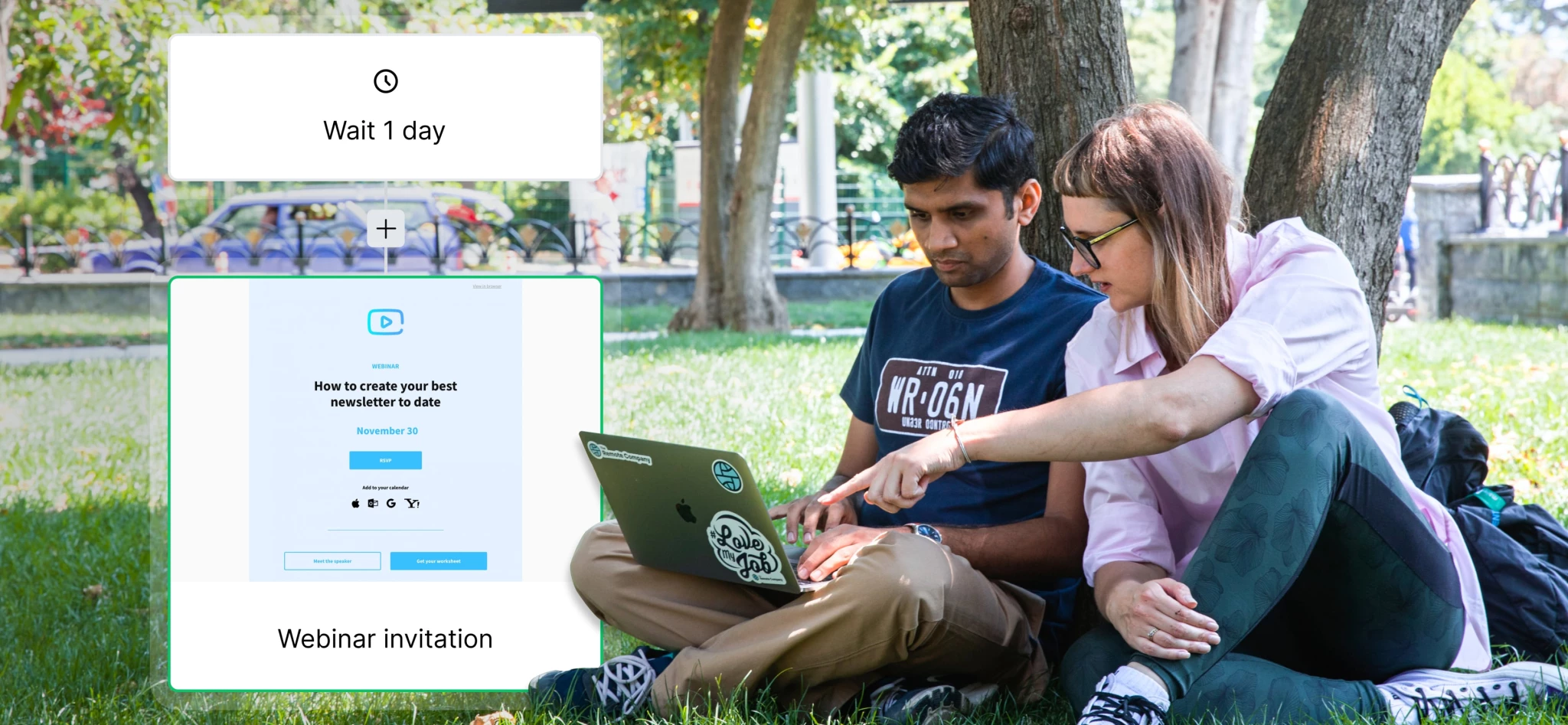 Mandar, Paid Advertising Specialist (left), and Rūta, Performance Lead (right)
Mandar, Paid Advertising Specialist (left), and Rūta, Performance Lead (right)
How great would it be to have a team of top salespeople working 24/7 to make sales for your business? While that’s out of reach for many small companies, automated lead nurturing emails can have a similar impact—and they’re extremely accessible.
Lead nurture emails provide leads with useful information and explain how your product helps them achieve their goals. They are critical to the sales process as they push the lead down the sales funnel. And the best thing? You can use email marketing software to create workflows that automate the entire process.
This article will tell you more about lead nurturing emails, explain the different types you can use, and highlight some best practices to help you create the best campaign possible. Let's get started!
What are nurture emails?
Nurture emails are the messages you send to leads to move them down the sales funnel. They build relationships with potential customers by helping them overcome challenges and achieve their goals.
These campaigns can consist of multiple email types. At the start of the sales cycle, the messages contain informational content that introduces your brand and helps the potential customer solve problems.
As the lead gets closer to the conversion stage of the funnel, the emails become more promotional. You can send discounts, free trial offers, or cart abandonment notifications.
The benefit of nurture email campaigns
Nurture email campaigns help turn leads who aren’t ready to buy into loyal customers. This is important because 96% of website visitors aren’t there to make a purchase, but they may be in the future. Therefore, a good nurture email strategy can help you get more sales, revenue and profit.
Send nurture emails at all stages of the email funnel. Send your first message as soon as the lead hands over their email address and continue until they purchase. You can even continue the lead nurturing email sequence after the lead becomes a customer to encourage repeat buys.
9 lead nurturing email examples
Nurture email campaigns consist of many types of emails. They can be anything that builds trust with the customer and pushes them toward a sale. Here are some common examples to inspire your next campaign.
1. Welcome email
A welcome email is a message you send to subscribers as soon as they join your list. Use this first email to introduce your brand, thank the lead for signing up, and explain the next steps they can take to connect. If the person signed up via a lead magnet, include a link to the download.
Get inspired ✨
This welcome email from MarketingProfs tells the recipient more about the company, points them toward useful links, explains how often to expect the newsletter, and has a subtle call to action for people ready to upgrade to a paid plan.
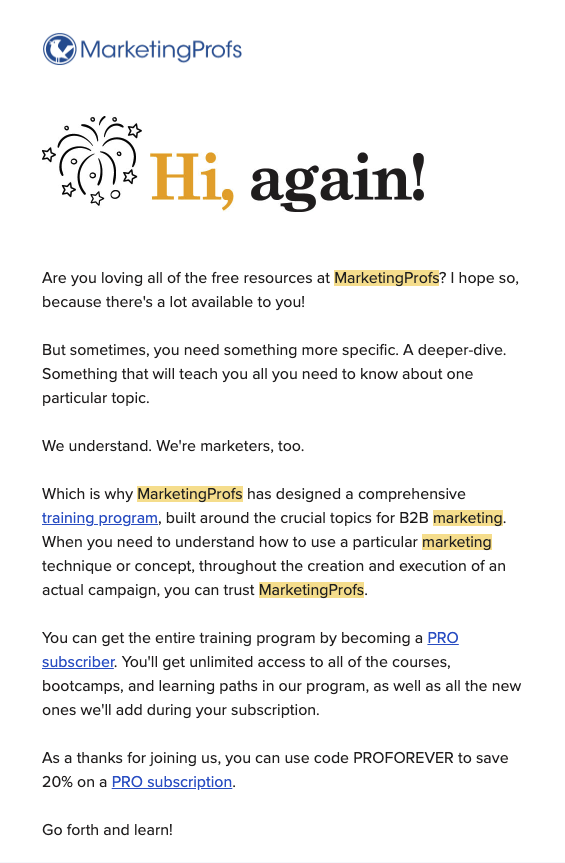
2. Educational content
Educational emails provide information about a problem the lead is struggling with related to your product or service. By solving the problem, you’ll position yourself as a trusted source of information and increase the chances that they keep opening your emails.
Get inspired ✨
Zapier shares guides subscribers can follow to create automations that solve their business problems. If people like the idea, they may sign up to create the automation for themselves.
This type of email is especially effective if you create groups based on the problems your subscribers are interested in solving. Once you have the groups, you can send extremely relevant help guides.
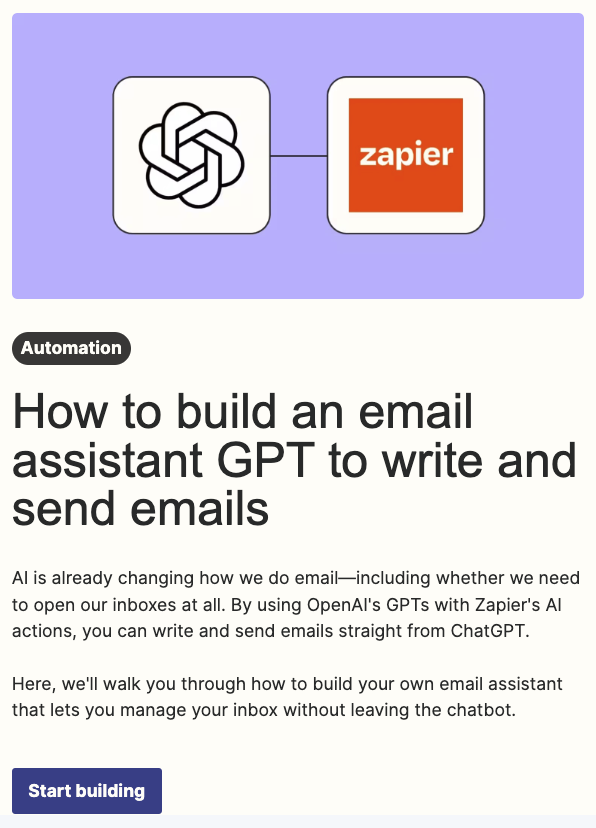
3. Product explainers
Nurture emails are an excellent chance to introduce your product and highlight what it can do. When sending these emails, don’t just send a list of features—highlight how the features benefit leads.
Get inspired ✨
This lead nurturing email example from Ezoic links to a blog post that shows how people can use the tool to host and display videos. The email is effective because it explains how adding videos to a website benefits the email recipient.
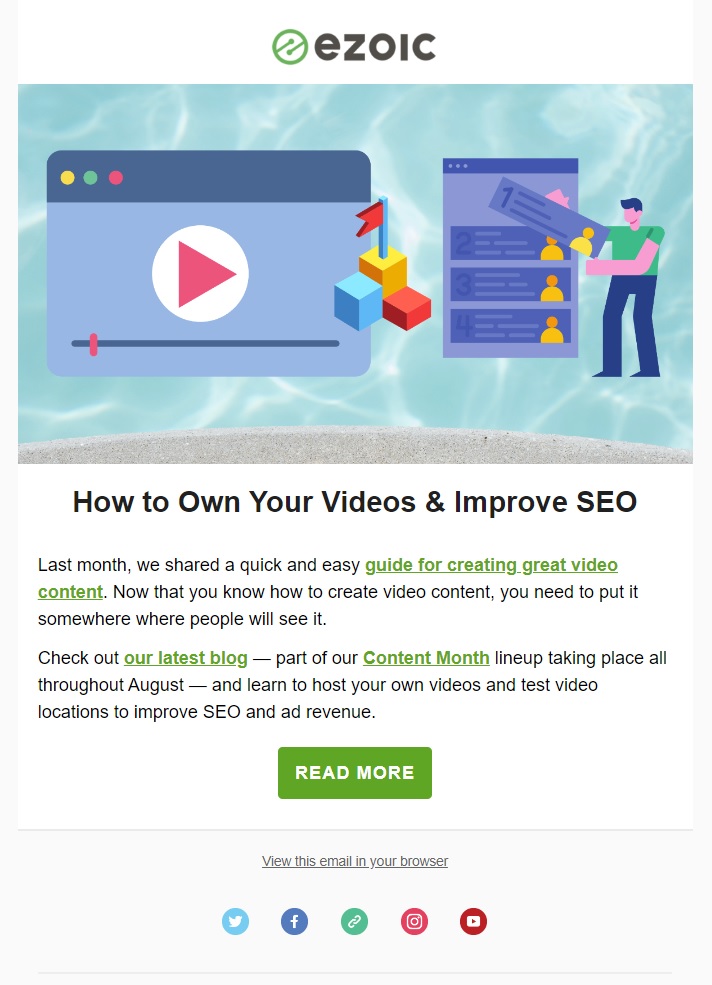
4. Product updates
Feature updates and new product emails keep subscribers in the loop about your brand. These new additions may convince the subscriber to go from an interested lead to a loyal customer.
Get inspired ✨
This nurture email example from Adalo introduces the app builder’s new features. It explains the benefits and links to landing pages with more information.
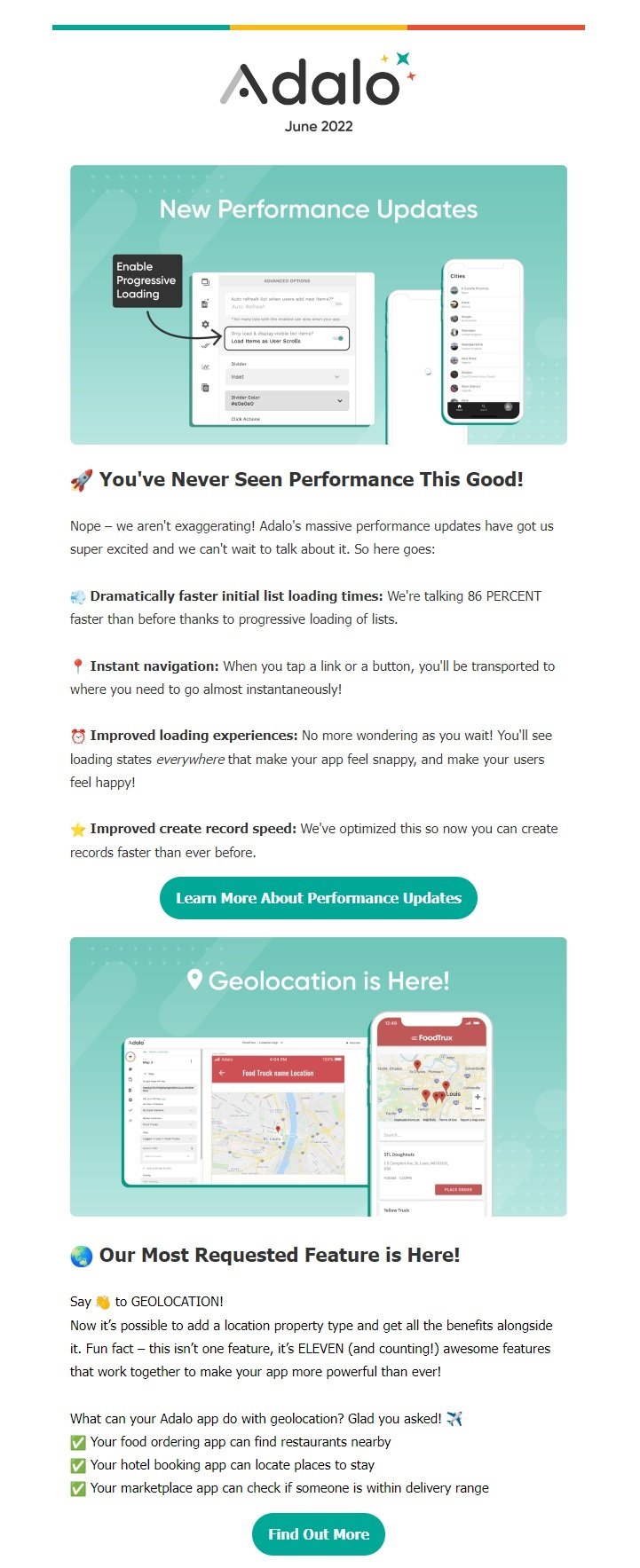
5. Exploratory emails
Use your nurture email to find out more about the customer’s specific problems. There are three ways you can do this:
Link to your preferences center so customers can choose which types of emails to receive.
Group customers based on the links they click on in your emails.
Use survey blocks to ask customers questions and then add them to groups based on these answers.
Once you know each customer’s interests, you can send further content that addresses these pain points.
Get inspired ✨
This lead nurturing example from Brightly lets families choose to browse either books for tweens or books for those aged over 13. If Brightly tracks which link recipients click on, it could group people based on clicks and send them relevant content.
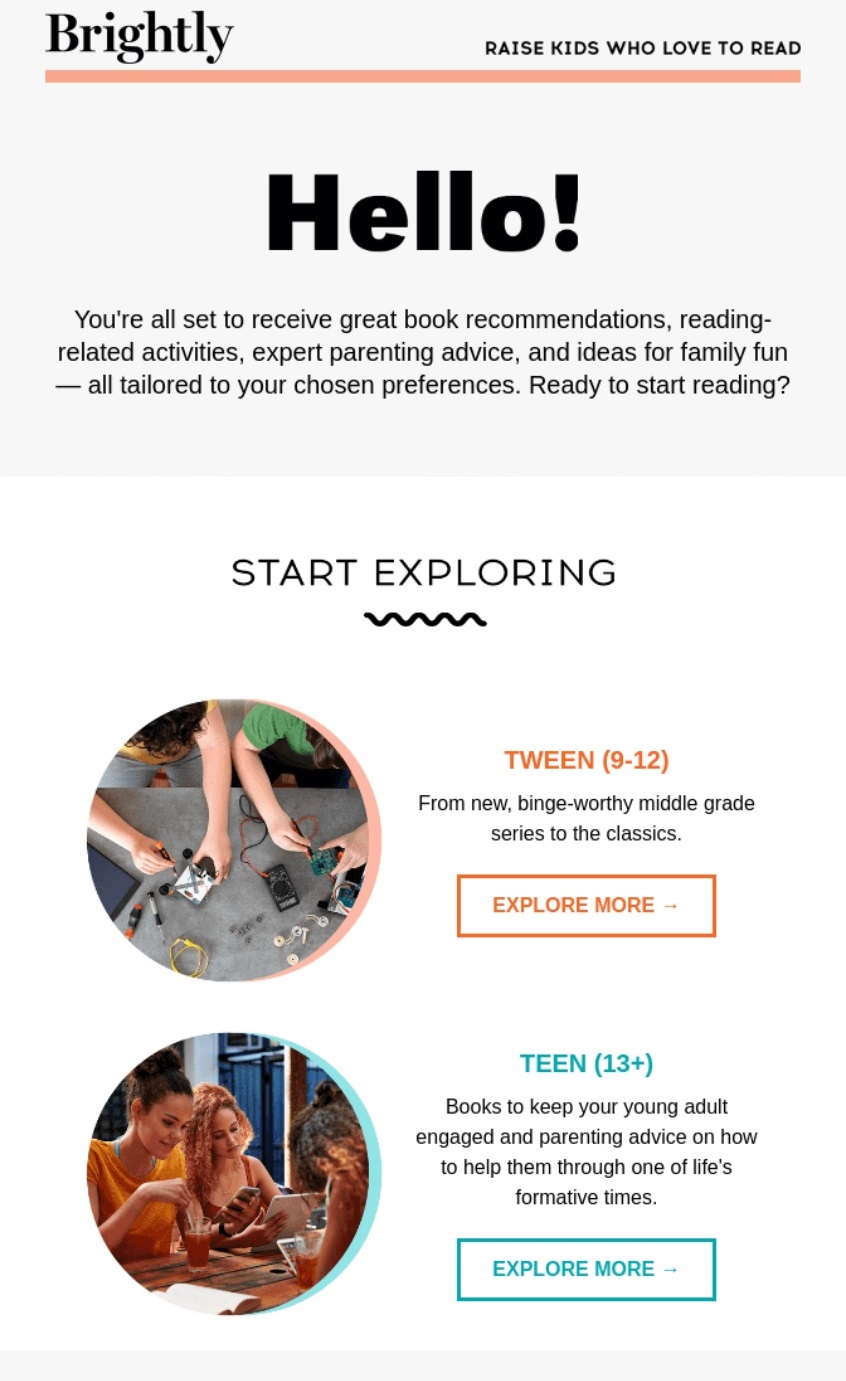
6. Social proof
Social proof is a powerful sales motivator. Take advantage of this by sending an email highlighting how other people use your product.
Some ways you can do this include:
Add testimonials to your email
Link to reviews on third-party sites
Create and share in-depth case studies
Embed social posts where people talk about your product
Try to use social proof that praises your brand while mentioning specific ways your product helps people similar to your lead.
Get inspired ✨
This nurturing campaign example from Feedly highlights how the platform’s power users make the most of the tool. It blends social proof with specific benefits for different types of people.

7. Webinar invites
Webinars are a great way to teach leads about an industry problem, which can position your brand as a trusted thought leader. And when people sign up for a webinar, you learn two super valuable pieces of information:
A specific problem they are struggling with and want to overcome
That they are invested in the process of learning about your brand
Use this information to send more content related to the problem and experiment with sending more promotional emails.
Get inspired ✨
This email from Rock Content invites recipients to a webinar about a timely problem many marketing leaders are likely struggling with. The email and webinar position the company as an industry authority.
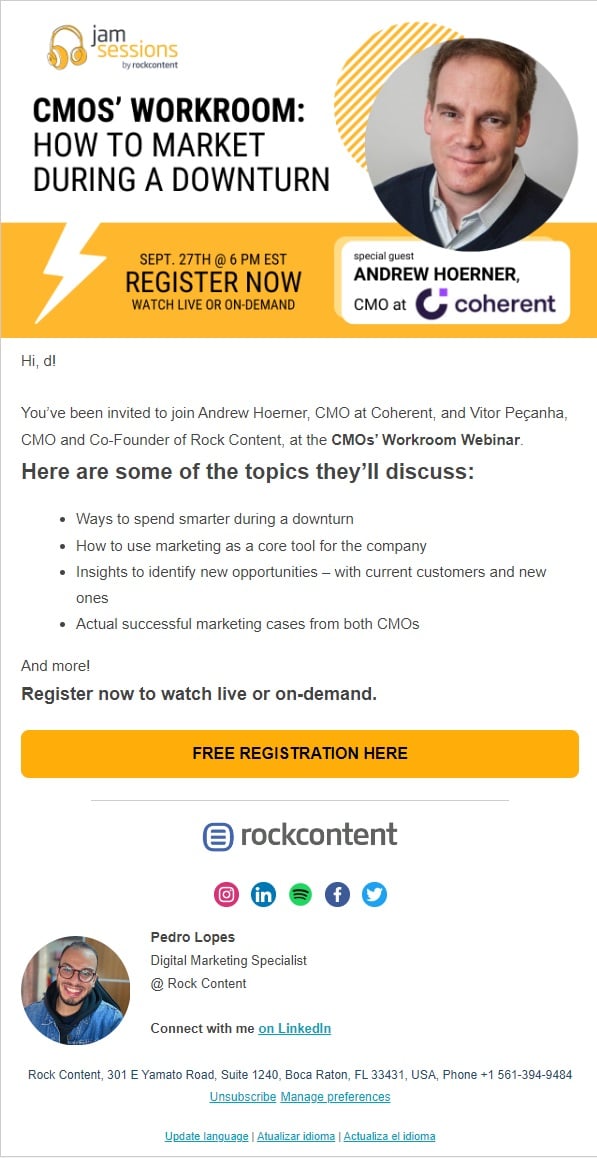
8. Discounts
Discounts are an effective way to nurture leads at the later stages of the buyer's journey. If the person is almost ready to buy, sending an email coupon can cause them to commit.
Get inspired ✨
This nurture example from Uber Eats contains a tempting £10 discount. The offer is made even more tantalizing by the inclusion of images from four local restaurants.

9. Cart abandonment
Cart abandonment emails are automated messages that go out when someone starts the checkout process but abandons it before finalizing the purchase. These emails are a super effective way for e-commerce stores to get the buyer back to the checkout so they can complete the purchase.
Get inspired ✨
This cart abandonment email from cosmetics firm Rudy’s stands out because it explains that the recipient has to buy soon to take advantage of free shipping. It also highlights products the customer was interested in and includes a call to action button that takes buyers back to the checkout page.
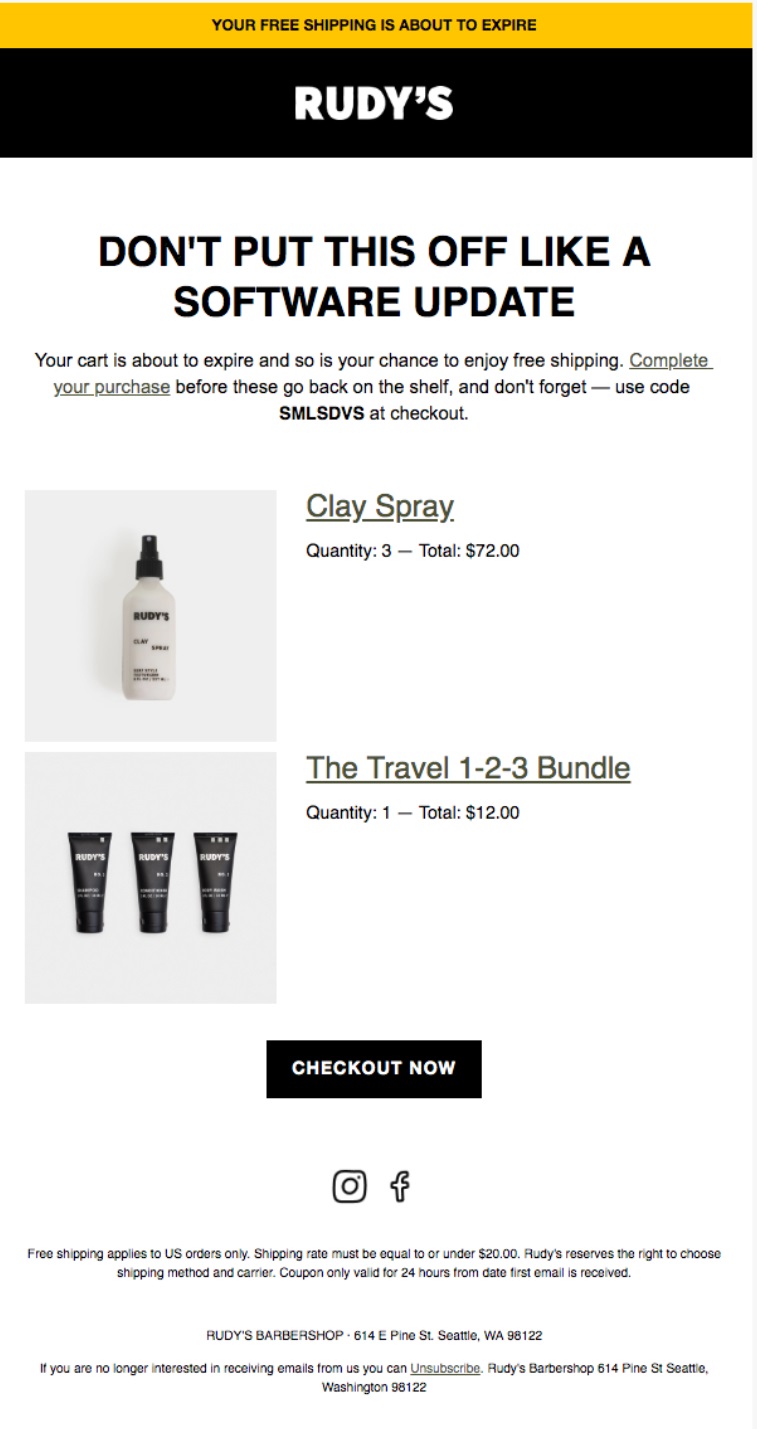
How to create an email nurture campaign
Here are 6 steps you can take when creating your email nurture campaign. Follow them to ensure your campaigns work towards your business goals and appeal to your customers.
1. Define your goals
Your nurture campaigns play a specific role in the lead's journey toward being a customer. When creating a nurture campaign, first consider the outcome you want to achieve so you can build your strategy around this goal.
Here are some common email nurture campaign goals:
Purchase a product
Set up a sales call or product demo
Attend a webinar
Sign up for a free trial
Download a content asset or template
Watch a product video
Choose one that makes sense for your business. An e-commerce nurture campaign will typically focus on purchases, while higher-ticket B2B products are more likely to focus on educational outcomes like product demos or webinars.
Once you know the reason for the campaign, the rest of the campaign creation process can be focused on this target.
2. Identify your audience
Nurture emails are most effective when they target a specific audience. This is because you can create a strategy that meets their needs exactly.
There are many ways to split up your audience. It could be by demographic or firmographic factors like:
Location
Industry
Company size
Role
Interests
Or you could split your audience based on the person’s position in your sales funnel. For example, whether they:
Signed up for a trial, demo or webinar
Engaged with your previous emails
Downloaded a specific piece of content
Used a particular feature during a free trial
The challenge is discovering this information. You can collect demographic and firmographic data by adding fields to your email signup forms that people can use to provide the information.
Other data, such as email engagement and content downloads, can be tracked within your email marketing platform’s analytics.
You’ll need to connect your email marketing platform with your product via its API or a pre-built integration to discover data such as how the lead uses your software.
3. Map out the customer journey
Nurture campaigns perform better if you have a good understanding of the customer journey.
If you know that people who receive a 10% discount coupon are more likely to buy than those who receive an offer for free shipping, you push people toward the former offer.
Your analytics platform will likely provide more information about how people move from leads to customers if you have tracking set up.
You can get further insight by speaking to your existing customers and learning about their journey. This will be especially effective if you have a limited number of customers.
4. Create compelling content
Creating content that interests the lead is perhaps the most important and difficult part of the nurture campaign creation process. You’ll need to create both promotional content like emails and forms, as well as the content resources, videos, and reports you use to get people to the next stage of the funnel.
Good content typically excels in 3 factors: the idea, design, and copy.
Here are 4 ways to discover content ideas that will appeal to your audience:
Analyze the content types and topics that get a lot of interaction in your industry.
Research the content your competitors create.
Speak to your customers to learn about their challenges.
Look at your website or social analytics to see your most popular content.
Best practices for design and copy are more complex, but our articles on email design and writing engaging email content have plenty of tips that will help.
If you don’t have the time or the skills, you can always hire a freelancer to create content for you. The MailerLite marketplace on Upwork has plenty of top talent who can create your campaigns.
5. Set up email automation and triggers
Automate your nurture campaign so it can convert future leads while you sleep. Use your email marketing platform to create an automated workflow that takes a particular action whenever someone triggers it.
The key is deciding what actions should trigger your automation. MailerLite has 10 prebuilt triggers you can use.
The most relevant ones for email nurture campaigns are:
Fills in a website form or pop-up
Clicks on a link in an email
Joins a group
Updates a profile field
Abandons checkout
Just choose the trigger that makes the most sense for your nurture campaign goal. You can then use our automation builder to define the actions that occur when someone triggers the campaign.
Below is an example nurture campaign for an imaginary software company that is triggered when someone downloads a lead magnet from the website.
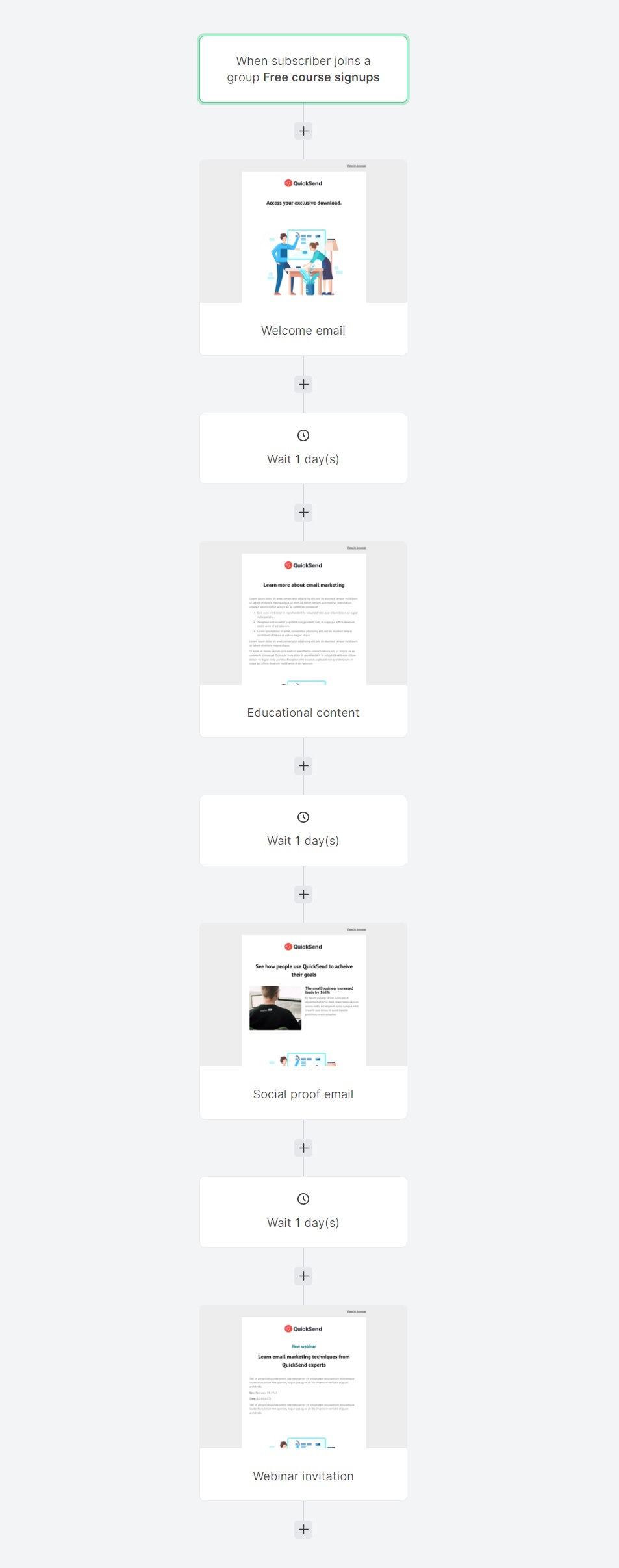
The sequence then provides more information about the problem the lead has shown an interest in before inviting the lead to a webinar.
The series consists of four different emails:
A welcome email that includes the lead magnet download link.
Educational content that discusses topics related to the lead magnet.
A social proof email that shows how customers are using the tool to help with their problems.
A webinar invitation email that provides further information about the topic.
Anyone who signs up for the webinar will be added to a new group for people who have shown a deeper interest in the product. These people will be targeted with a more sales-focused automation.
Start with email automation
Build automated email sequences to nurture leads and generate sales.
6. Test and optimize
Once your emails are live, check your reporting dashboard to see how they perform and then optimize based on these insights.
You can also use A/B or multivariate testing to pit different versions of an email, subject line, or sender name against each other to see which results in the most opens and clicks.
Once you know the winner, roll this out in all future campaigns so you always use the email most likely to lead to engagement.
Best practices for next-level email nurture campaigns
1. Make contact fast
People who hand over their email addresses want to hear from you. Their interest is high, and they are willing to start building a relationship. Make the most of this interest by sending a welcome email as soon as they sign up for your list.
With MailerLite, you can do this by connecting an email automation to your signup form. People who fill out the form will instantly receive the message.
2. Segment your audience
Nurture emails are most effective when they target the specific needs and challenges facing a lead.
It's impossible to know every person who signs up for your email list on a personal level. But you can segment or group your list based on interests or behaviors and send relevant content to each one.
With MailerLite, you can add users to different groups depending on how they interact with your sign-up form or campaign.
Here are some ways you could do this:
Group users based on the offer they sign up for
Group users based on the links they click on from within your campaign
Use a preference center to let leads tell you what they are most interested in
Use survey or quiz blocks in your campaign
Once you have set up your groups, create content and emails targeted at each one. Read this article for more tips about email marketing segmentation.
3. Personalize your emails
Using groups and segments and then creating emails targeted at the needs of types of customers will help you create a more personalized experience. But you can take this further by using data you have about your customers to personalize the content of the email to them specifically.
The most common example of this is using the subscriber’s name in the email content or subject line, which you can do by adding the tag {$name}. This will add the data in the Name field of the customer’s profile when sending the email.
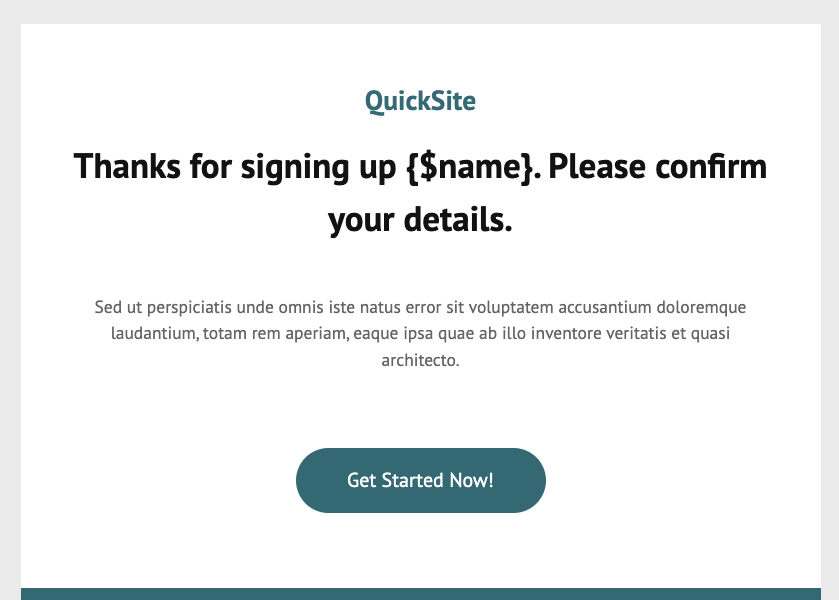
Other ways you can personalize the email include mentioning their company, industry, location or any other data point you collect during the sign-up and lead nurture process. Just add a custom tag to your email that’s related to a field in your profile.
Find out more about creating and using custom tags in this article.
3. Provide value
Nurture campaigns shouldn’t be promotional unless they specifically target bottom-of-the-funnel prospects. At all other stages of the funnel, you should focus on giving subscribers value.
When you provide value, people are more likely to continue opening your emails and interacting with your brand.
Consider using email surveys to discover your customer's needs and challenges. You can easily embed surveys into your emails using the MailerLite survey block. Find out more about creating survey emails here.
5. Test your email performance
A/B testing your emails helps you create more effective email nurturing campaigns.
Things you can test include:
Subject line: Test different versions and see which leads to a higher open rate
CTA buttons: See which CTAs cause people to click through to your landing page
Offers: See which offer results in more people clicking through to your site
Personalization: Using the recipient’s personal information can increase click-through rate (CTR). Test emails with different types of personalization
Email content: Discover whether images, videos, social media embeds, text or headlines impact your CTR
MailerLite makes it super easy to run A/B tests. Create different versions of your email, choose which metric you want to test, and then choose the percentage of your list that will receive each email.
The tool will then automate the test and send the winning email to the remaining portion of your list.
6. Use newsletters for long-term nurturing
Even the most complex nurture sequences end. But you don’t want to ignore people when they reach the end of your automated series as they may still be interested in your product.
Continue the lead nurturing campaign by sending a newsletter to all your subscribers. Use this to keep the lead up-to-date with your brand while sending helpful information that can help with their problems
The MailerLite newsletter summarizes our latest blog posts to provide subscribers with actionable tips and insights they can use to improve their email marketing. We also add information about product updates, courses, and support videos to keep people in the loop.
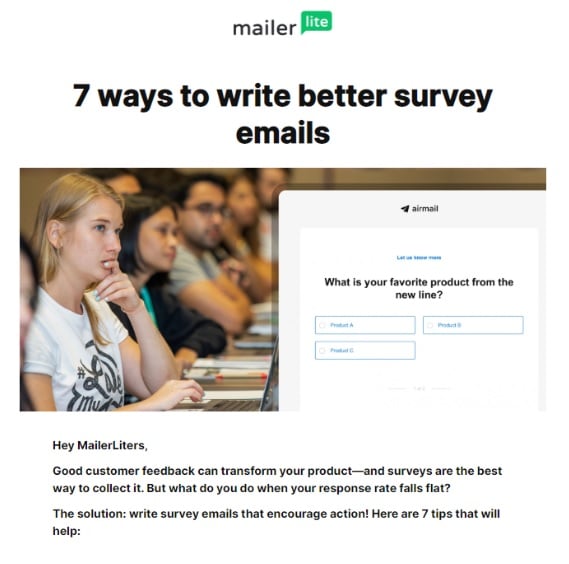
One final nurture email idea 💡
An effective nurture email campaign builds the relationship with the reader and provides the information they need to become a customer. It’s an essential part of an email marketing campaign as it helps turn people from subscribers into customers.
Our final tip is to remember that you’re unlikely to come up with the perfect strategy right away. Keep experimenting and testing nurture email campaigns to see what works and what doesn’t.
Get this right and it won’t be long before you’re creating effective emails that target your audience’s needs and challenges. You’ll build trust, stronger relationships, and make more sales in the long term.
Editor's note: This article was originally published in 2022 and has been updated with more up-to-date instructions.
